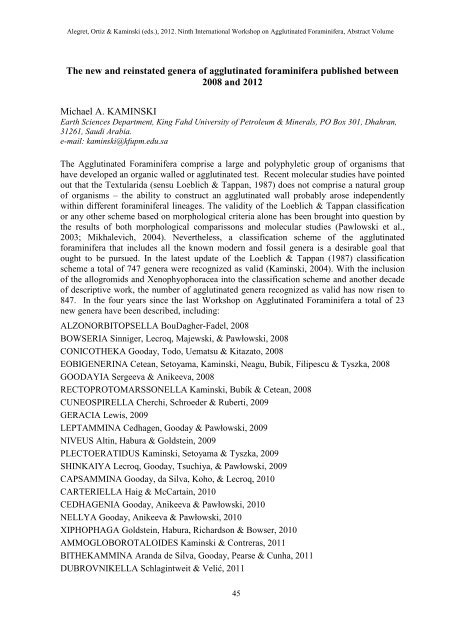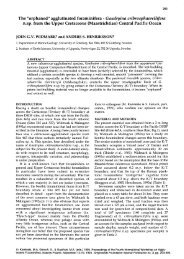Full Text | Download - Grzybowski Foundation - The ...
Full Text | Download - Grzybowski Foundation - The ...
Full Text | Download - Grzybowski Foundation - The ...
You also want an ePaper? Increase the reach of your titles
YUMPU automatically turns print PDFs into web optimized ePapers that Google loves.
Alegret, Ortiz & Kaminski (eds.), 2012. Ninth International Workshop on Agglutinated Foraminifera, Abstract Volume<br />
<strong>The</strong> new and reinstated genera of agglutinated foraminifera published between<br />
2008 and 2012<br />
Michael A. KAMINSKI<br />
Earth Sciences Department, King Fahd University of Petroleum & Minerals, PO Box 301, Dhahran,<br />
31261, Saudi Arabia.<br />
e-mail: kaminski@kfupm.edu.sa<br />
<strong>The</strong> Agglutinated Foraminifera comprise a large and polyphyletic group of organisms that<br />
have developed an organic walled or agglutinated test. Recent molecular studies have pointed<br />
out that the <strong>Text</strong>ularida (sensu Loeblich & Tappan, 1987) does not comprise a natural group<br />
of organisms – the ability to construct an agglutinated wall probably arose independently<br />
within different foraminiferal lineages. <strong>The</strong> validity of the Loeblich & Tappan classification<br />
or any other scheme based on morphological criteria alone has been brought into question by<br />
the results of both morphological comparissons and molecular studies (Pawlowski et al.,<br />
2003; Mikhalevich, 2004). Nevertheless, a classification scheme of the agglutinated<br />
foraminifera that includes all the known modern and fossil genera is a desirable goal that<br />
ought to be pursued. In the latest update of the Loeblich & Tappan (1987) classification<br />
scheme a total of 747 genera were recognized as valid (Kaminski, 2004). With the inclusion<br />
of the allogromids and Xenophyophoracea into the classification scheme and another decade<br />
of descriptive work, the number of agglutinated genera recognized as valid has now risen to<br />
847. In the four years since the last Workshop on Agglutinated Foraminifera a total of 23<br />
new genera have been described, including:<br />
ALZONORBITOPSELLA BouDagher-Fadel, 2008<br />
BOWSERIA Sinniger, Lecroq, Majewski, & Pawłowski, 2008<br />
CONICOTHEKA Gooday, Todo, Uematsu & Kitazato, 2008<br />
EOBIGENERINA Cetean, Setoyama, Kaminski, Neagu, Bubík, Filipescu & Tyszka, 2008<br />
GOODAYIA Sergeeva & Anikeeva, 2008<br />
RECTOPROTOMARSSONELLA Kaminski, Bubík & Cetean, 2008<br />
CUNEOSPIRELLA Cherchi, Schroeder & Ruberti, 2009<br />
GERACIA Lewis, 2009<br />
LEPTAMMINA Cedhagen, Gooday & Pawłowski, 2009<br />
NIVEUS Altin, Habura & Goldstein, 2009<br />
PLECTOERATIDUS Kaminski, Setoyama & Tyszka, 2009<br />
SHINKAIYA Lecroq, Gooday, Tsuchiya, & Pawłowski, 2009<br />
CAPSAMMINA Gooday, da Silva, Koho, & Lecroq, 2010<br />
CARTERIELLA Haig & McCartain, 2010<br />
CEDHAGENIA Gooday, Anikeeva & Pawłowski, 2010<br />
NELLYA Gooday, Anikeeva & Pawłowski, 2010<br />
XIPHOPHAGA Goldstein, Habura, Richardson & Bowser, 2010<br />
AMMOGLOBOROTALOIDES Kaminski & Contreras, 2011<br />
BITHEKAMMINA Aranda de Silva, Gooday, Pearse & Cunha, 2011<br />
DUBROVNIKELLA Schlagintweit & Velić, 2011<br />
45



